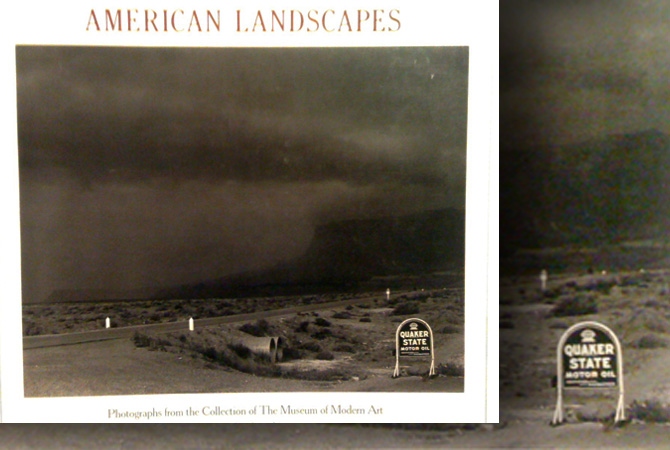American Landscapes: Photographs from the Collection of The Museum of Modern Art – John Szarkowski – 1981 – Mint condition – 55 black-and-white plates, 3 text illustrations
ONLY $7.95 (ORIGINAL PRICE FROM 1981!!)
(From the back cover)
Landscape pictures, often thought of as being an ancient genre, constitute a relatively recent one. Our modern concept of landscape developed around the end of the eighteenth century, states John Szarkowksi in hi introductory essay: “this [new] idea was that the natural site is not merely an ideal setting for beautiful or heroic acts, but that it is in itself a primary source of meaning, and an original pedagogue.” By nineteenth century, the American artists’ idea of nature ahead developed into something very different from the European artists’“the American concept of landscape was that of an unpeopled wilderness, while the traditional European idea was one of a tamed pastoral beauty inhabited by man. “The problem was not solved but redefined, by men who were not artist in the traditional sense,” states Szarkowksi. “These were the photographers who during the last third of the nineteenth century photographed the unsettled American West.” (BUY NOW ON AMAZON!)
Fifty-five master photographs from the collection of The Museum of Modern Art illustrate the response of American photographers to the particular challenge of the American terrain. Beginning with the first generation of photographers, who were “explorers, adventurers, technicians, and entrepreneurs,” and ending with contemporary landscape photographers, each of the photographers represented has attempted to define what the earth is like and has presented new discoveries concerning the structure, the beauty, and the meaning of the habitat. Men like Timothy O’Sullivan and William Henry Jackson accompanied survey expeditions into the American West, confronted the wilderness, and created image of great force and excellence. Their successors celebrated nature in accordance with their temperaments and concern with the formal problems of picture-making. (BUY NOW ON AMAZON!)
John Szarkowski’s thoughtful essay comments on Edward Weston’s developing control of the complex orders of landscape, proceeding from the detail toward the large landscape, until “no space seemed too broad or too deep”; on the quasi-impressionistic approach of Edward Steichen and Clarence White; on Alfred Stieglitz’s “special closeness to the secrets of creation”; on Ansel Adam’s portrayal of the drama of light in “a place that seems much like Eden.” As for contemporary photographers, the author points out that many have begun to pay respectful attention our “scarred and harshly used” earth, “trusting that attention will grow into affection, and affection into a measure of competence, so that w might in time learn again to live not merely on the but with it.”
Other photographers whose work is represented in the book include Harry Callahan, Paul Caponigro, Lee Friedlander Laura Gilpin, Darius Kinsey, Dorothea Lange, Frank Gohlke, Frederick Sommer, Paul Strand, Minor White, and many others.(BUY NOW ON AMAZON!)

